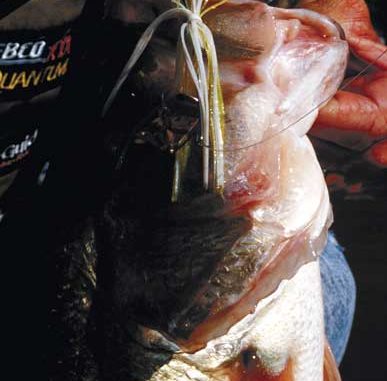
Nothing is more exciting that watching a huge bass strike a buzzbait.
Although largemouths will bite buzzbaits year round, one particular week is better than all others (in my opinion).
My next-door neighbor, Steve, once told his boss he was taking off work the last week of October. His boss said: “What’s going on that week?”
“That’s National Buzzbait Week,” Steve said.
The last week of October has always been my favorite time for buzzbaits in North Carolina.
The reason I remember this trend is that every Halloween, I usually wear out bass using buzzbaits. The last month of October usually coincides with are some of N.C.’s first big cool snaps that knock down water temperature and send bass into a feeding frenzy in the shallows.
Late October can produce low water levels (or really high water from a hurricane or tropical storm). But one thing holds true nearly every year — that’s when bass really eat buzzbaits. Clear or muddy, cloudy or sunny; it doesn’t matter.
However, proper techniques and equipment are crucial for using buzzbaits successfully.
These lures come in a variety of sizes, colors and styles, and all have a best time to use. Anglers should treat them as tools and pick the most efficient one for the task at hand.
I like to keep it simple with regard to colors, often using just white or black. Occasionally I get fancy during clear-water conditions or if bass are feeding heavily on a certain baitfish. Color isn’t as important with buzzbaits as it is with other lures, as the disturbance of the blades breaks up the lure image and tricks bass.
Trailer hooks are a must for almost all buzzbaits, as up to 50 percent of my fish are hooked by the trailers.
I use at least 15-pound-test line most of the time because the line’s usually out of the water and the monofilament doesn’t affect action the lure’s action. Also, for fishing big flats I like 15-pound line so I can get some extra distance with it.
For target fishing and heavy slop, I increase the line test to 20-pound fluorocarbon or 65- pound Daiwa braided line.
The best rods I’ve found are 7-foot-long Daiwa Cielo, a 7-1 Steez heavy-action and Daiwa’s new Zillion reel with a 7.1:1 gear ratio.
For 1/8-ounce buzzbaits,anglers might need to drop down to a medium-heavy action rod for easier casting.
I generally focus my efforts by using three buzzbait types — low-riding buzzbaits, skimmer style buzzbaits and buzz frogs.
By rotating through these types of buzzbaits, bass will tell you which one they like best.
Low-riding buzzbaits have a bend in the wire so they ride low and get better hookups; they’re excellent for all-around buzzbait fishing. However, their use should be limited in shallow weeds where they ride too low and will get fouled by vegetation.
Skimmer-style buzzbaits include the Chatterbuzz. With a straight wire and flat head, this lure will power its way through anything.
The blade is tuned so it strikes the lead head and makes a chattering noise as it comes across the surface, often serving as a triggering mechanism.
I often reach for this style when bass have a shortened strike zone — such as a hole in the grass or thick wood. The clacking alerts fish to its presence before they see the lure. It’s good to use in a thick-cover environment or with a little chop on the water.
I prefer the Culprit buzz frog because it’s tougher, larger and doesn’t slide down the hook as much as other types.
These lures are great where weeds are matted on the surface or if there’s an algae bloom that will foul a standard buzz bait.
Some days a squeaky buzzbait will outfish a quieter one. One trick to get such a buzzbait to squeak more is to crimp the clevis in front of the blade; that creates more friction and more squeal.
Also, try painting the blades with clearcoat to make them squeak more. The neat thing about this tactic is the more they’re used, the more they squeak.
Another trick to put a big fish in the boat is to create the illusion that your bait is much bigger that it really is by using a solid-colored blade. An all-white skirt and all-white blades apparently look larger to a bass than a multi-colored buzzbait.
Although I don’t always use a solid blade, it comes out when I’m hunting a “kicker” fish.
Most bass strikes when using a buzzbait come after the first 5 feet of the retrieve. So the No. 1 skill to learn is how to get your lure on the surface with the blade turning the moment a buzzbait hits the water.
Most anglers cast right handed and reel right handed, so we have to switch the rod to the left hand before beginning the retrieve. The key is to switch hands while the lure still is in the air and not in the water.
Stop the line with your thumb as it hits the water and lift the rod tip to get the bait moving at same time you begin reeling. The No. 1 mistake I see anglers make is not getting a buzzbait on the surface immediately and headed back to the boat.
It just takes a little practice to learn this trick.
Hope to see you on the water this National Buzzbait Week 2007.
Dustin Wilks is a 30-year-old professional bass angler and Raleigh native now living in Rocky Mount. He has qualified for the Bassmaster Classic four times and operates Fish Like a Pro Fishing Lessons (252-883-6749, www.fishlikeapro.com ). His sponsors include Skeeter Boats, Yamaha, Daiwa, Keelshield and Culprit.



Be the first to comment